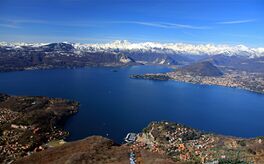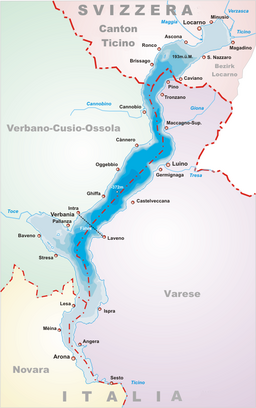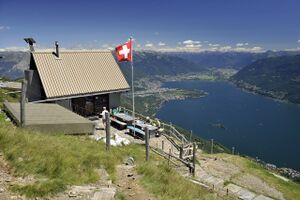بحيرة ماجورى
| بحيرة ماجورى | |
|---|---|
| |
 منظر بحيرة ماجورى باتجاه الألپ ومونتى روزا من فوق لاڤينو | |
 | |
| الموقع | لومبارديا وبييمونتي بإيطاليا تيسينو بسويسرا |
| الإحداثيات | 46°05′53″N 08°42′53″E / 46.09806°N 8.71472°E |
| الموارد الرئيسية | نهر تسين، نهر ماجيا، توتشى، نهر تريزا |
| التصريفات الرئيسية | نهر تيتشينو |
| منطقة المستجمعات | 6,599 كم² |
| بلدان الحوض | إيطاليا، سويسرا |
| أقصى طول | 64.37 كم |
| أقصى عرض | 10 كم |
| مساحة السطح | 212.5 كم² |
| متوسط العمق | 177.4 متر |
| أقصى عمق | 372 متر |
| حجم المياه | 37.7 كم³ |
| زمن المكوث | 4 أعوام |
| ارتفاع السطح | 193 متر |
| الجزر | جزر بريساجو، جزر بوروميان |
| التجمعات السكنية | أرونا، لوكارنو، لوينو، ستريسا، فربانيا |
بحيرة ماجورى (UK: /mæˈdʒɔːreɪ, ˌmædʒiˈɔːreɪ/, US: /mɑːˈdʒɔːreɪ, məˈdʒɔːri/;[1][2][3] إيطالية: Lago Maggiore النطق بالإيطالية: [ˈlaːɡo madˈdʒoːre]; Western Lombard: Lagh Maggior; Piedmontese: Lagh Magior; literally 'greater lake') or Verbano (النطق بالإيطالية: [verˈbaːno]; لاتينية: Lacus Verbanus) هي بحيرة كبيرة تقع على الجانب الجنوبي من جبال الألب. كما أنها ثاني أكبر بحيرة في إيطاليا والأكبر في جنوب سويسرا. تنقسم البحيرة وشواطئها بين المناطق الإيطالية في لومبارديا وپيدمونت، والكانتون السويسري تيتشينو. وتقع بحيرة ماجوري في منتصف الطريق بين بحيرة أورتا وبحيرة لوگانو، وتمتد لمسافة 64 كم بين لوكارنو وأرونا. مناخها معتدل في الصيف والشتاء، وتلائم نباتات البحر الأبيض المتوسط، حيث تزرع العديد من الحدائق نباتات نادرة وغريبة. وتشمل الحدائق المعروفة تلك الموجودة في الجزر البورومية وجزر بريساجو، وحدائق فيلا تارانتو في ڤربانيا، و حديقة ألبينيا النباتية بستريسا. يرفد بحيرة ماجوري بواسطة نهر تيتشينو، وهو رافد رئيسي لنهر بو. يجمع حوضه أيضًا مياه العديد من البحيرات الكبيرة، ولا سيما بحيرة لوگانو (عبر تريزا) وبحيرة أورتا وبحيرة ڤاريزي.[4]
الجغرافيا
Lake Maggiore is 64.37 km (40 mi) long, and 3 إلى 5 km (2 إلى 3 mi) wide, except at the bay opening westward between Pallanza and Stresa, where it is 10 km (6 mi) wide. It is the longest Italian lake, although Lake Garda has a greater area. Its mean height above the sea level is 193 metres; a deep lake, its bottom is almost everywhere below sea-level: at its deepest, 179 metres below. Its form is very sinuous so that there are few points from which any considerable part of its surface can be seen at a single glance. If this lessens the effect of the apparent size, it increases the variety of its scenery. While the upper end is completely alpine in character, the middle region lies between hills of gentler form, and the lower end advances to the verge of the plain of Lombardy.[5] Lake Maggiore is the most westerly of the three great southern prealpine lakes, the others being Lake Como and Lake Garda.
The lake basin has tectonic-glacial origins and its volume is 37 متركيلو مكعب (9 cu mi).[بحاجة لمصدر] The lake has a surface area of about 213 متر كيلومربع (82 sq mi), a maximum length of 54 km (34 mi) (on a straight line) and, at its widest, is 12 km (7 mi).[بحاجة لمصدر] Its main tributaries are the Ticino, the Maggia (forming a very large delta), the Toce (by which it receives the outflow of Lake Orta) and the Tresa (which is the sole emissary of Lake Lugano). The rivers Verzasca, Giona, and Cannobino also flow into the lake. Its outlet is the Ticino which, in turn, joins the river Po just south-east of Pavia.
The lake's jagged banks are surrounded by the Pennine and Lepontine Alps, and Lugano Prealps. Prominent peaks around the lake are the Gridone, Monte Tamaro, Monte Nudo and the Mottarone. The highest mountain overlooking Lake Maggiore is Monte Rosa (4،634 m؛ 15،203 ft), located about 50 كيلومتر (31 mi) west of it. The western bank is in Piedmont (provinces of Novara and Province of Verbano-Cusio-Ossola) and the eastern in Lombardy (province of Varese), whereas the most northerly section extends 13 كيلومتر (8 mi) into the canton of Ticino, where it constitutes its lowest point above sea level as well as that of Switzerland. The culminating point of the lake's drainage basin is the Grenzgipfel summit of Monte Rosa at 4،618 متر (15،151 ft) above sea level.[6]
المناخ
Lake Maggiore weather is humid subtropical (Cfa in the Köppen climate classification). During winter, the lake helps to maintain a higher temperature in the surrounding region (since water releases heat energy more slowly than air). The temperatures are cooled down in summer by the breezes that blow on the water's surface, changing its colour. The area enjoys nearly 2300 hours of sunshine a year and an average annual temperature of 15.5 °C (60 °F). The water of the lake has a comfortable temperature of 20 إلى 22 °C (68 إلى 72 °F) in July and August. In winter snowfall is erratic and primarily affects the higher elevations. Rainfall is heaviest in May and lowest during the winter months.[7][8][9]
النبيت والوحيش
The flora is strongly influenced by the lake basin, which has allowed the proliferation of typically Mediterranean plants, and also of plants native to the Atlantic areas favoured by the composition of the soil and the abundance of siliceous rocks. Lemons, olive trees and bay olive trees grow there.[بحاجة لمصدر] The spontaneous vegetation is composed of yew, holly and chestnut trees on the surrounding hills.
In the lake two species of whitefish live, Coregonus and, less widespread, Coregonus lavaretus. Both live in deep water and come ashore only during the spawning in early December. There are also perch, pike, chub, burbot, torpedo, eels and Alburnus arborella. The lake is home to several species of nesting waterfowl, it also represents an important corridor, a place of rest and feeding for migrations. For example: common merganser, royal swan, grebes, gulls, cormorants, ducks.[10]
A number of exotic species have established themselves in the lake, including pikeperch, which has been recorded since 1977; wels catfish, which was first noticed in the early 1990s; and ruffe, introduced in the mid-1990s. Wels catfish in excess of 50 kg in weight have been fished from the lake.[11]
البلدات والقرى على البحيرة
| سويسرا، كانتون تيتشينو |
إيطاليا، إقليم پيدمونت مقاطعة ڤربانو-كوزيو-أوسولا ومقاطعة نوڤارا |
إيطاليا، إقليم لومبارديا مقاطعة ڤاريزى |
|---|---|---|
الجزر
- Borromean Islands (three islands and two islets located between Verbania to the north and Stresa to the south)
- Isola Bella
- Isola Madre
- Isola dei Pescatori (or Isola Superiore)
- Isolino di San Giovanni (in front of Verbania)
- Scoglio della Malghera (between Isola Bella and Isola Pescatori)
- Brissago Islands (close to Brissago)
- San Pancrazio (or Grande Isola)
- Isolino (or Isola Piccola or Isola di Sant’Apollinare)
- Castelli di Cannero (three small islands just off the shore from Cannero Riviera)
- Isolino Partegora (in the gulf of Angera)
الجبل المقدس گيفا
The Sacred Mountain of Ghiffa is a Roman Catholic devotional complex in the comune of Ghiffa, (Piedmont, northern Italy), overlooking Lake Maggiore. It is one of the nine Sacri Monti of Piedmont and Lombardy, included in the UNESCO World Heritage list.
الأحداث
The Spirit of Woodstock Festival is an annual open air festival at the end of July/beginning of August. It is organized in Armeno by the Mirapuri community.
التاريخ

The first archaeological findings around the lake belong to nomadic people living in the area in prehistoric types. The first settlements discovered date from the Copper Age. Along the shores of the lake, between the 9th and 4th centuries BC. J.-C., develops the Golasecca culture, Celts civilization of the iron age. The latter was in turn conquered by the Romans, who called the lake Verbanus Lacus or Lacus Maximus. In Roman times a maritime line was created that linked the lake, thanks to Ticino, to Pavia, from where the ships would then continue along the Po to the Adriatic Sea.[12]
After the fall of the Western Roman Empire, the lake was under different domains. Most of the current settlements originated in the Middle Ages when the lake was under the Della Torre, Visconti, the Borromeo and Habsburg families.
Clashes also took place on the waters of the lake between military fleets, such as in 1263, when the Della Torre ships fought against those of the Visconti near Arona or, between 1523 and 1524, when the Borromeo clashed against Francesco II Sforza and in 1636 between French and Spanish always in the waters between Arona and Angera.[13]
From the fourteenth century until the end of the eighteenth century, navigation on the lake and on the Ticino was also used to transport the heavy blocks of marble obtained from the quarries located around the lake towards the main Lombard construction sites: the cathedral of Milan and the Certosa di Pavia.[14]
Methane was first discovered and isolated by Alessandro Volta as he analysed marsh gas from Lake Maggiore, between 1776 and 1778.[15]
From the middle of the 19th century, the lake began to experience strong tourist development, particularly after Queen Victoria's stay in Baveno in 1879.[16]
In 1936, a Bugatti Type 22 Brescia Roadster, built 1925, was sunk in the lake by employees of Zürich architect Marco Schmucklerski, when Swiss customs officials investigated whether he had paid taxes on the car. The Bugatti was attached to an iron chain making it possible to recover it once the investigation was over, yet that never happened. When the chain corroded, the car sunk to the lake bed, where it was rediscovered on 18 August 1967 by local diver Ugo Pillon and became a favourite target for divers thereafter. When one of the divers, Damiano Tamagni, was killed in a hold-up on 1 February 2008, his friends from the Ascona divers' club decided to lift and sell the car wreck to raise funds for a yet-to-be-created foundation named after the victim. The remains of the Bugatti were recovered on 12 July 2009. The sale took place at the Retro Mobile classic car exhibition in Paris on 23 January 2010. It was sold for €260,500.[17]
In May 2021, a cable car collapsed near the lake, killing 14 people.[18]
In May 2023 a boat capsized in a storm while travelling between Arona and Sesto Calende, killing 4 people.[19]
حادثة فندق ماينا على بحيرة ماجورى
This incident is part of the Lake Maggiore massacres during WWII.
Meina is a municipality located 77 كيلومتر (48 ميل) northwest of Milan, on the southern shores of Lake Maggiore. The Hotel Meina was located north of the town of Meina and was owned by Alberto and Eugenia Behar, Sephardic Jews who had moved to Italy from Constantinople. In September 1943, an armistice was declared between Italy and the Allies. At that time, the Hotel Meina housed a number of Jewish guests, most of them escapees of the Nazi occupation of Greece.[20] The area around Lake Maggiore was not under Allied control but was occupied by the German Waffen-SS, specifically the infamous Leibstandarte SS Adolf Hitler. Captain Hans Krüger, who directed operations in Meina and the surrounding villages, was in charge of locating the Jews in that area and was responsible for the Lake Maggiore massacres in which approximately 54 Jews were murdered.
On the night of 22 September 1943, most of the Jewish residents of the Hotel Meina were executed and their bodies were thrown into Lake Maggiore. The Fernandez-Diaz family, a family of Greek Sephardic Jews from Thessaloniki, barricaded themselves in one of the fourth-floor hotel rooms. It took an extra day for the Germans to reach and execute them. The family included three young children whose lives were not spared despite pleas from older family members. Among those killed were Dino Fernandez-Diaz (76 years old), Pierre Fernandez-Diaz (46), Liliane (Scialom) Fernandez-Diaz (36), Jean Fernandez-Diaz (17), Robert Fernandez-Diaz (13), Blanchette Fernandez-Diaz (12), Marco Mosseri (55), Ester Botton (52), Giacomo Renato Mosseri (22), Odette Uziel (19), Raoul Torres (48), Valerie Nahoum Torres (49), and Daniele Modiano (51). In total, sixteen Jewish residents of the hotel were executed. Its owners, the Behar family, survived due to the efforts of the Turkish consulate.
The Italian police report on the Meina massacre was lost but resurfaced in 1994, along with hundreds of other files of war crimes committed post-armistice by Germans who still occupied or were retreating from Italian soil. These files had been hidden in a wooden cabinet, the so-called "cabinet of shame", discovered in a storeroom of the military prosecutor's headquarters.
Germany does not extradite its citizens convicted of war crimes in other countries. Those responsible for the Meina massacre were tried at home in Germany in 1968, convicted and sentenced to life in prison.[21] However, in 1970, the German Supreme Court declared the statute of limitations for those particular war crimes to have expired, and the prisoners were released.
الإشارات في الأدب وفي الثقافة الشعبية
Lake Maggiore is featured in American writer Ernest Hemingway's novel A Farewell to Arms. The protagonist (Frederic Henry) and his lover (Catherine Barkley) are forced to cross the transnational border within the lake in a row boat to escape Italian carabinieri.
It also appeared as the location of a fictional racetrack in the racing game Gran Turismo Sport and Gran Turismo 7.
Die Flippers, a German Schlager group wrote a song called "Lago Maggiore" that appears on their 1990 album Sieben Tage Sonnenschein.
انظر أيضاً
المصادر
- ^ "Maggiore". Collins English Dictionary. HarperCollins. Retrieved 28 May 2019.
- ^ "Maggiore, Lake" (US) and "Maggiore, Lake". Lexico UK English Dictionary. Oxford University Press. Archived from the original on 2021-04-16.
- ^ قالب:Cite Merriam-Webster
- ^ Swisstopo topographic maps.
- ^ this paragraph is taken largely verbatim from John Ball, The Alpine Guide, Central Alps, 1856, p. 306
- ^ 1:25,000 topographic map (Map). Swisstopo. Retrieved 2014-07-28.
- ^ The history of Lake Maggiore lagomaggioreonline.it. Retrieved 2010-03-12
- ^ Lake Maggiore myswitzerland.com. Retrieved 2010-03-12
- ^ Lago maggiore - a popular holiday destination in Switzerland as well travel-swiss.co.uk. Retrieved 2010-03-12
- ^ "NUMEROSI UCCELLI ACQUATICI SUL LAGO MAGGIORE". Archived from the original on 2013-07-29.
- ^ Volta, Pietra; Jeppesen, Erik; Sala, Paolo; Silvia, Galafassi; Foglini, Claudio; Puzzi, Cesare; Winfield, Ian J. (10 July 2017). "Fish assemblages in large Italian subalpine lakes: history and present status with an emphasis on non-native species". Hydrobiologia. 824 (1): 255–270. doi:10.1007/s10750-018-3621-0. S2CID 254544327. Retrieved March 10, 2023.
- ^ Piazzesi, Paolo (2012). Lago Maggiore e le isole Borromee. Storia, monumenti, arte. Milano: Rotalsele. pp. 2–8. ISBN 9788864780719.
- ^ Romanoni, Fabio (2023). La guerra d’acqua dolce. Navi e conflitti medievali nell’Italia settentrionale. Bologna: Clueb. pp. 108–109. ISBN 978-88-31365-53-6. Retrieved 26 April 2023.
- ^ icvbc.cnr.it. "LE PIETRE IMPIEGATE NELL'ARCHITETTURA MILANESE E LOMBARDA". icvbc.cnr.it. National Research Council (Italy). Retrieved 26 April 2023.
- ^ alessandrovolta.it. "Il Metano". alessandrovolta.it. Fondazione Alessandro Volta. Retrieved 26 April 2023.
- ^ Piazzesi, Paolo (2012). Lago Maggiore e le isole Borromee. Storia, monumenti, arte. Milano: Rotalsele. pp. 10–11. ISBN 9788864780719.
- ^ "RFI - 260,500 euros for rusty old car found at bottom of lake". Rfi.fr. Retrieved 2013-03-26.
- ^ "Thirteen dead after cable car falls in Italy". BBC News. 23 May 2021. Retrieved 23 May 2021.
- ^ "Italy: Agents die when boat capsizes on Lake Maggiore". BBC News (in الإنجليزية البريطانية). 2023-05-30. Retrieved 2023-05-30.
- ^ Ventura, Andrea; Franzinelli, Mimmo (2013-01-27). "The Hôtel Meina". The New York Times. Retrieved 2019-10-31.
- ^ "Three former Hitler bodyguards sentenced to life for killing Jews in northern Italy" (PDF). Vol. 35, no. 129. Bonn: Jewish Telegraphic Agency. 1968-07-08. p. 4. Retrieved 2019-10-31.
وصلات خارجية
 Coolidge, William Augustus Brevoort (1911). . In Chisholm, Hugh (ed.). دائرة المعارف البريطانية. Vol. 17 (eleventh ed.). Cambridge University Press. p. 304.
Coolidge, William Augustus Brevoort (1911). . In Chisholm, Hugh (ed.). دائرة المعارف البريطانية. Vol. 17 (eleventh ed.). Cambridge University Press. p. 304. {{cite encyclopedia}}: Cite has empty unknown parameter:|coauthors=(help)- CIPAIS Commissione Internazionale per la Protezione delle Acque Italo-Svizzere (in إيطالية) limnologic reports on the Lake Maggiore and Lake Lugano
- Official website of Ascona-Locarno Tourism
- Pages using gadget WikiMiniAtlas
- CS1 الإنجليزية البريطانية-language sources (en-gb)
- Articles containing إيطالية-language text
- Articles containing Lombard-language text
- Articles containing Piedmontese-language text
- Coordinates on Wikidata
- Pages using Lang-xx templates
- Articles containing لاتينية-language text
- Articles with unsourced statements from November 2022
- مقالات المعرفة المحتوية على معلومات من دائرة المعارف البريطانية طبعة 1911
- Articles with إيطالية-language sources (it)
- بحيرة ماجورى
- International lakes of Europe
- Italy–Switzerland border
- Lakes of Lombardy
- Lakes of Piedmont
- Lakes of the Swiss Alps
- Lakes of Ticino
- Lepontine Alps
- Province of Novara
- Province of Varese
- Province of Verbano-Cusio-Ossola
- Subalpine lakes of Italy
- Waterways of Italy


